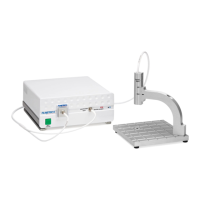Case #1: No oscillations, or portions of oscillations, are present in the measured reflectance
spectrum.
Case #2: The measured reflectance spectrum has periodic oscillations across the entire
screen, but its minima and maxima do not match up with the calculated reflectance.
Case #3: Two or more different, but nearly the same, thickness readings are obtainable from
the same measurement location.
Case #4: Not all of the measured spectrum displays oscillations
Case #5: Poor matches between the measured and calculated reflectance spectra when meas-
uring thickness and optical constants.
Case #6: Several different answers, or one unreasonable answer, are found when measuring
thickness and optical constants, even though a good match is found between the measured
and calculated reflectance spectra.
Case 1: No oscillations, or portions of oscillations, are present in the
measured reflectance spectrum.
There can be several causes of this. The simplest is that the film may just be very thin (<200 Å).
Also, if the film is very rough, non-uniform in thickness over the measurement area, or has a
graded interface, it may not support coherent optical interference, and thus it may not be able to be
measured. Another cause of no oscillations can be an improper baseline measurement, so usually
the first step when no oscillations are seen is to carefully retake the baseline.
Case 2: The measured reflectance spectrum has periodic oscillations
across the entire screen, but its minima and maxima do not match up
with the calculated reflectance.
The most common cause is that the initial thickness guess was considerably different than the
actual film thickness, and due to the constraints on possible thicknesses, FILMeasure was not able
to look for an answer in the region of the actual thickness. To understand this, it helps to know that
the number of oscillations on the screen is proportional to the film thickness. For example, if the
measured spectrum has roughly twice the number of the oscillations that the calculated spectrum
has, then the measured film is roughly twice the thickness of the calculated thickness. Using this
information, the initial thickness guess and the thickness constraints can be set more appropriately
in the Edit Recipe dialog box. Another possible cause is found in Case #3 (incorrect dispersion).
Case 3: Two or more different, but nearly the same, thickness readings
are obtainable from the same measurement location.
When this occurs usually the measured and calculated spectra match somewhat, but not very well
across the entire spectra (i.e., the measured and calculated spectra match only over a small

